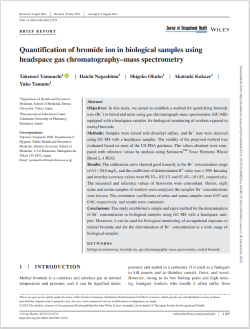#0136 Quantification of bromide ion in biological samples using headspace gas chromatography–mass spectrometry

Quick and Easy Detection of Methyl Bromide Exposure
Methyl bromide is used as a fumigant to control a wide range of pests in agriculture and shipping. It is also used to treat commodities like cereals, fruits, and wood to prevent pest infestation. However, methyl bromide is a toxic substance. Since it evaporates quickly, it causes the most harm at the fumigation site. Therefore, fumigant workers who handle it often suffer from acute or chronic poisoning.
In addition, methyl bromide has been designated as an ozone-depleting compound, and its use in soil fumigation has been forbidden since 2013. Although its overall consumption has decreased, its use as a pesticide has remained rather high. This makes it necessary to monitor occupational exposure of workers to this chemical.
Determining the concentration of bromide ions (Br–) in the blood and urine is a means to identify whether workers have been exposed to methyl bromide. Many techniques have been developed to achieve this goal. However, the majority of these techniques need a large number of samples for analysis. Moreover, these methods are difficult and time-consuming, rendering them unsuitable for emergency diagnostics.
Fortunately, in a recent study, a group of researchers from Japan have devised a simple and rapid method for determining Br– concentration in blood and urine samples. The method essentially employs a gas chromatograph-mass spectrometer (GC-MS) with a headspace sampler that characterizes the composition of complex volatile components. The accuracy of estimation was validated using SeronormTM Trace Elements Whole Blood L-1 RUO, which helps in determining the approximate levels of Br– and other trace elements in whole blood.
Applying this method, the researchers analyzed the Br– content in eight urine and serum samples from workers. The outcomes were comparable to previously established techniques. The method demonstrated high recovery rates and negligible variations in accuracy values. It also displayed superior quantification in the Br– concentration range of 0.1−20.0 mg/L. The entire process took less than 20 minutes, making it ideal for the rapid diagnosis of acute poisoning cases. The researchers attest this to be a sensitive method that may be less affected by interference components, potentially leading to a more accurate analysis.
Although the proportion of the workforce exposed to methyl bromide is unlikely to rise in the future, it is critical to develop a convenient method for determining the concentration of Br– in biological samples. This study offers a valuable method for quick, easy, and efficient biological monitoring of occupational exposure to methyl bromide.

Link to original journal article:
https://academic.oup.com/joh/article/63/1/e12274/7249850
Title of the paper:
Quantification of bromide ion in biological samples using headspace gas chromatography–mass spectrometry
Authors:
Takenori Yamauchi, Daichi Nagashima, Shigeko Okubo, Akatsuki Kokaze, and Yuko Yamano




